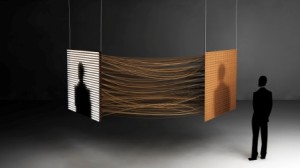A Parallel Image 2009

Gebhard Sengmüller, Franz Büchinger
http://www.gebseng.com/08_a_parallel_image/
Sponsored by: Fels-Multiprint
In 1880 the French engineer Maurice Leblanc defined for the first time the principle for transmitting images with electricity, which is still valid today.
The basis for this was the idea that an image to be transmitted is broken down into lines; the light impulses are transformed into electrical currents; the sender and receiver of the image must be synchronized; the transmitted electric signals are ultimately transposed into light values on a screen again; and that the picture lines are then recomposed synchronously in time.
The breakdown of images already proposed at that time first became practically possible with the conception of the Nipkow disk by Paul Nipkow in 1883. This was successfully employed for the first time in 1926 by the Scotsman John Logie Baird in an electromechanical television system, the Televisor.
Electronic television is also based on this principle idea of breaking down images into image lines and the therefore requisite time synchronization between sender and receiver.
“A Parallel Image” starts from the assumption that the development just described never happened.
With this claim Gebhard Sengmüller attempts to develop a television format that is useless in its efficiency, but nevertheless technically entirely feasible. His format chooses a parallel transmission of every single pixel, which makes a technically elaborate synchronization in time between sender and receiver superfluous.
Taking this idea to its logical conclusion, this leads to an absurd system that connects a grid of 2500 photoconductors on the sender side with 2500 small light bulbs on the receiver side, pixel by pixel, using a total of 2500 copper wires.
Unlike most media systems today, a direct experience is possible with “A Parallel Image”. Visitors can intervene directly in this interactive sculpture: the outlines of their bodies appear without delay on the monitor. It is possible to play with this image by changing the distance to the camera, etc.
Swivelling the photo lens (or projecting a film onto the camera surface) also makes it possible to render bodies and objects in their gradations of brightness and their plasticity. The starkly reduced resolution of this camera obscura leads at the same time to an image that clearly indicates the process it is based on in its quality.
